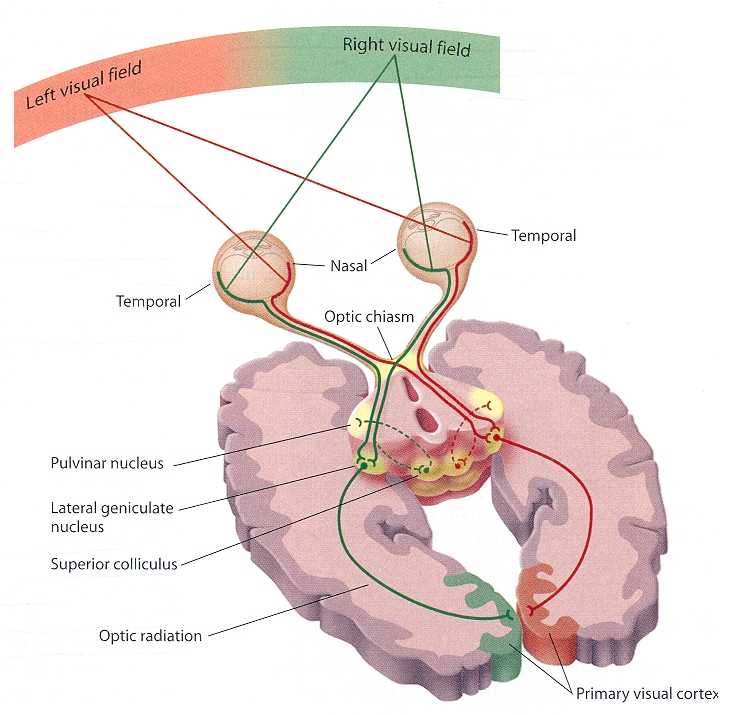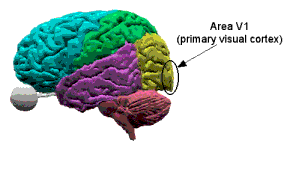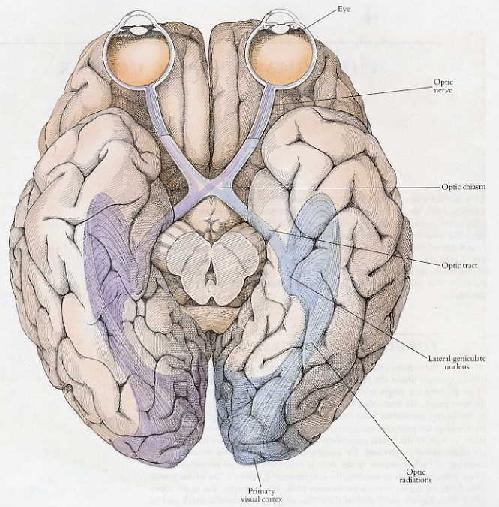|
Connections between cells CONNECTIONS BETWEEN BIPOLAR CELLS AND GANGLION CELLS
We have seen that the main features of the ganglion-cell receptive fields are to be found already in the bipolar cells. This leaves open the question of what transformations of information occur between bipolars and ganglion cells. It is hardly likely that nothing happens, if the complexity of the synaptic layer between the middle layer and ganglion-cell layer is any indication, for here we often find convergence between bipolars and ganglion cells in the direct path, and also the intervention of amacrine cells, whose functions are not well understood.
The synapses between bipolar cells and ganglion cells are probably all excitatory, and this means that on-center bipolar cells supply on-center ganglion cells, and off-center bipolars supply off-center ganglion cells. That simplifies the circuit: we could have had on-center cells supplying off-center cells through inhibitory synapses, for example. We should be thankful for small
mercies.
Until 1976, it was not known whether on-center cells and off-center cells differed in their shapes, but in that year Ralph Nelson, Helga Kolb, and Edward Famiglietti, at the National Institutes of Health in Bethesda, recorded intracellularly from cat ganglion cells, identified them as on- or off-center, and then injected a dye through the microelectrode, staining the entire dendritic tree. When they compared the dendritic branchings in the two cell types they saw a clear difference: the two sets of dendrites terminated in two distinct sublayers within the synaptic zone between the middle and ganglion-cell layers. The off-center-cell dendrites always terminated closer to the middle layer of the retina, the on-center dendrites, farther. Other work had already shown that two classes of bipolar cells, known to have different-shaped synapses with receptors, differed also in the position of their axon terminals, one set ending where the on-center ganglion-cell dendrites terminated, the other, where the off-center dendrites terminated. It thus became possible to reconstruct the entire path from receptors to ganglion cells, for both on-center and off-center systems.
One surprising result of all this was to establish that, in the direct pathway, it is the off-center system that has excitatory synapses at each stage, from receptors to bipolars and bipolars to ganglion cells. The on-center path instead has an inhibitory receptor-to-bipolar synapse.
The separation of bipolar cells and ganglion cells into on- and off-center categories must surely have perceptual correlates. Off-center cells respond in exactly the same way to dark spots as on-center cells respond to bright spots. If we find it surprising to have separate sets of cells for handling dark and light spots, it may be because we are told by physicists, rightly, that darkness is the absence of light. But dark seems very real to us, and now we seem to find that the reality has some basis in biology. Black is as real to us as white, and just as useful. The print of the page you are reading is, after all, black.
An exactly parallel situation occurs in the realm of heat and cold. In high school physics we are amazed to learn that cold is just the absence of heat because cold seems equally real—more so if you were brought up, as I was, in frigid Montreal. The vindication of our instinct comes when we learn that we have two classes of temperature receptors in our skin, one that responds to the raising of temperature, and another to lowering. So again, biologically, cold is just as real as hot.
Many sensory systems make use of opposing pairs: hot/cold, black/white, head rotation left/head rotation right—and, as we will see in Chapter 8, yellow/blue and red/green. The reason for opposing pairs is probably related to the way in which nerves fire. In principle, one could imagine nerves with firing rates set at some high level—say, 100 impulses per second—and hence capable of firing slower or faster—down to zero or up to, say, 500—to opposite stimuli. But because impulses require metabolic energy (all the sodium that enters the nerve has to be pumped back out), probably it is more efficient for our nerve cells to be silent or to fire at low rates in the absence of a sensory stimulus, and for us to have two separate groups of cells for any given modality—one firing to less, the other to more.
|
Specialized cells AMACRINE CELLS
These cells come in an astonishing variety of shapes and use an
impressive number ofneurotransmitters. There may be well over twenty different types. They all have in common, first, their location, with their cell bodies in the middle retinal layer and their processes in the synaptic zone between that layer and the ganglion cell layer; second, their connections, linking bipolar cells and retinal ganglion cells and thus forming an alternative, indirect route between them; and, finally, their lack ofaxons, compensated for by the ability of their dendrites to end presynaptically on other cells.
Amacrine cells seem to have several different functions, many of them unknown: one type of amacrine seems to play a part in specific responses to moving objects found in retinas of frogs and rabbits; another type is interposed in the path that links ganglion cells to those bipolar cells that receive rod input.
Amacrines are not known to be involved in the center-surround organization of ganglion-cell receptive fields, but we cannot rule out the possibility. This leaves most of the shapes unaccounted for, and it is probably fair to say, for amacrine cells in general, that our knowledge of their anatomy far outweighs our understanding of their function. |
|
Capsule Story Certainly the visual cortex is of critical importance to human survival. This part of David Hubel's book seeks to examine the durable structures we owe our vision to in the cortex.
The eye does more than just passivley sense and sens sensory data via the optic nerve to the brain. Instead the ganglion responds with respect to differences in light intensity with respect to light intensity departing from an average intensity.
Experimental evidence confirms the role of the ganglion in processing light intensity. As he concludes "what counts is the relative illumination of the spot" and its background or surrounding illumination.
Physiology dictates how the eye reveals a vivid quaility in an indirect manner.
|
Center Surround fields THE SIGNIFICANCE OF CENTER-SURROUND FIELDS
Why should evolution go to the trouble of building up such curious entities as center-surround receptive fields? This is the same as asking what use they are to the animal. Answering such a deep question is always difficult, but we can make some reasonable guesses. The messages that the eye sends to the brain can have little to do with the absolute intensity of light shining on the retina, because the retinal ganglion cells do not respond well to changes in diffuse light. What the cell does signal is the result of a comparison of the amount of light hitting a certain spot on the retina with the average amount falling on the immediate surround.
We can illustrate this comparison by the following experiment. We first find an on-center cell and map out its receptive field. Then, beginning with the screen uniformly and dimly lit by a steady background light, we begin turning on and off a spot that just fills the field center, starting with the light so dim we cannot see it and gradually turning up the intensity. At a certain brightness, we begin to detect a response, and we notice that this is also the brightness at which we just begin to see the spot. If we measure both the background and the spot with a light meter, we find that the spot is about 2 percent brighter than the background. Now we repeat the procedure, but we start with the background light on the screen five times as bright. We gradually raise the intensity of the stimulating light. Again at some point we begin to detect responses, and once again, this is the brightness at which we can just see the spot of light against the new background. When we measure the stimulating light, we find that it, too, is five times as bright as previously, that is, the spot is again 2 percent brighter than the background. The conclusion is that both for us and for the cell, what counts is the relative illumination of the spot and its surround.
The cell's failure to respond well to anything but local intensity differences may seem strange, because when we look at a large, uniformly lit spot, the interior seems as vivid to us as the borders. Given its physiology, the ganglion cell reports information only from the borders of the spot; we see the interior as uniform because no ganglion cells with fields in the interior are reporting local intensity differences. The argument seems convincing enough, and yet we feel uncomfortable because, argument or no argument, the interior still looks vivid! As we encounter the same problem again and again in later chapters, we have to conclude that the nervous system often works in counterintuitive ways. Rationally, however, we must concede that seeing the large spot by using only cells whose fields are confined to the borders—instead of tying up the entire population whose centers are distributed throughout the entire spot, borders plus interior—is the more efficient system: if you were an engineer that is probably exactly how you would design a machine. I suppose that if you did design it that way, the machine, too, would think the spot was uniformly lit.
In one way, the cell's weak responses or failure to respond to diffuse light should not come as a surprise. Anyone who has tried to take photographs without a light meter knows how bad we are at judging absolute light intensity. We are lucky if we can judge our camera setting to the nearest f-stop, a factor of two; to do even that we have to use our experience, noting that the day is cloudy-bright and that we are in the open shade an hour before sunset, for example, rather than just looking. But like the ganglion cell, we are very good at spatial comparisons —judging which of two neighboring regions is brighter or darker. As we have seen, we can make this comparison when the difference is only 2 percent, just as a monkey's most sensitive retinal ganglion cells can.
This system carries another major advantage in addition to efficiency. We see most objects by reflected light, from sources such as the sun or a light bulb. Despite changes in the intensity of these sources, our visual system preserves to a remarkable degree the appearance of objects. The retinal ganglion cell works to make this possible. Consider the following example: a newspaper looks roughly the same—white paper, black letters—whether we view it in a dimly lit room or out on a beach on a sunny day. Suppose, in each of these two situations, we measure the light coming to our eyes from the white paper and from one of the black letters of the headline. In the following table you can read the figures I got by going from my office out into the sun in the Harvard Medical School quadrangle: Outdoors Room.
The figures by themselves are perfectly plausible. The light outside is evidently twenty times as bright as the light in the room, and the black letters reflect about one-tenth the light that white paper does. But the figures, the first time you see them, are nevertheless amazing, for they tell us that the black letter outdoors sends twice as much light to our eyes as white paper under room lights. Clearly, the appearance of black and white is not a function of the amount of light an object reflects. The important thing is the amount of light relative to the amount reflected by surrounding objects.
A black-and-white television set, turned off, in a normally lit room, is white or greyish white. The engineer supplies electronic mechanisms for making the screen brighter but not for making it darker, and regardless of how it looks when turned off, no part of it will ever send less light when it is turned on. We nevertheless know very well that it is capable of giving us nice rich blacks. The blackest part of a television picture is sending to our eyes at least the same amount of light as it sends when the set is turned off. The conclusion from all this is that "black" and "white" are more than physical concepts; they are biological terms, the result of a computation done by our retina and brain on the visual scene.
As we will see in Chapter 8, the entire argument I have made here concerning black and white applies also to color. The color of an object is determined not just by the light coming from it, but also—and to just as important a degree as in the case of black and white—by the light coming from the rest of the scene. As a result, what we see becomes independent not only of the intensity of the light source, but also of its exact wavelength composition. And again, this is done in the interests of preserving the appearance of a scene despite marked changes in the intensity or spectral composition of the light source. |






